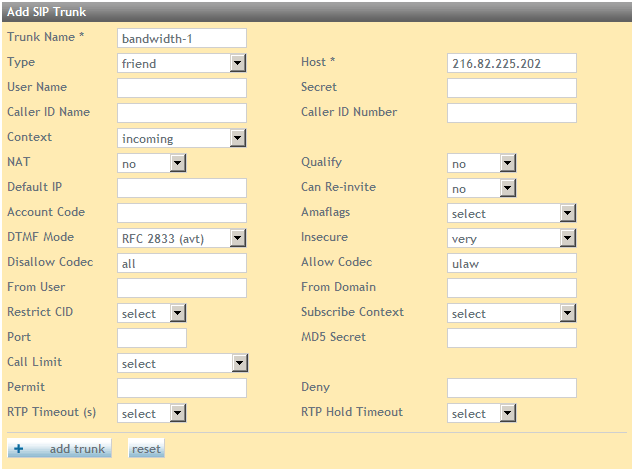Bandwidth.com
From Taridium
This page describes how to configure your Taridium ipbx system with Bandwidth.com SIP Trunking Service.
Contents |
Prerequisites
Completely installed ipbx System
If you have obtained your ipbx system directly from Taridium and have a valid maintenance or managed VoIP service contract, you can ask Taridium to perform this configuration for you. In order for you to configure your trunk you should have your phones, IVRs, call groups, queues etc. already setup. See Installing ipbx and Initial_Configuration|Initial Configuration]].
Version Check
![]() Bandwidth.com trunks require ipbx v. 2.0.1 or higher for proper operation.
Bandwidth.com trunks require ipbx v. 2.0.1 or higher for proper operation.
SIP trunking information provided by Bandwidth.com
- Primary, SIP proxy server IP address 216.82.224.202
- Secondary, SIP proxy server IP address 216.82.225.202
- Or, you can use DNS SRV ot.bandwidth.com (only the bandwidth.com EdgeMarc router supports this)
- Trunking DID(s)
Trunk Configuration
Navigate and login to the ipbx administrator interface (you will need admin class permissions). E.g.
http://[ip address of your pbx]/ipbx/
Click on Configuration → VoIP Trunks → add SIP Trunk
Enter the following details:
- Trunk Name → bandwidth-1
- Type → friend
- Host → 216.82.225.202
- Context → incoming (default)
- Can Re-Invite → no
- Insecure → very
- Disallow → all (enter or select all)
- Allow → ulaw (enter or select ulaw)
Leave all other configuration details as per default.
Click on add trunk to add your trunk to the configuration.
Click on Configuration → Routing → Outbound Routing
Enter your destination patterns and select the newly created SIP/bandwidth-1 trunk to terminate your calls.
Examples destination pattern:
_+ZXXXXXX. This will accept any numbers that match the E.164 pattern and send them to bandwidth.com
Transformation Configuration
Since bandwidth.com requires numbers to be dialed as fully qualified E.164 numbers you will need to add number transformations before sending your calls out.
Click on Configuration → Routing → Transformations
Add a new rule of type before outbound routing with Pattern _1NXXNXXXXXX and Output +${EXTEN} - This rule will transform any North American numbers to E.164.
Add a new rule of type before outbound routing with Pattern _011ZXXXXX. and Output +${EXTEN:3} - This rule will transform any international prefix numbers to an E.164 pattern.
If desired you can also add inbound transformations before inbound routing which for example could strip the + sign for further matching in your inbound routes.
DID Configuration
In order for ipbx to know about your DIDs, you will have to add inbound routes:
Click on Configuration → Routing → Inbound Routing
Enter your DIDs as specified by bandwidth.com e.g. +12125552200 and select a local destination for your DID.
Testing
Remember that Bandwidth.com wants to see a + and a 1 on all outgoing calls, so this must be planned for in the Trunk and Outbound Routing and Transformations. Also, we will be sending you a + and a 1 on every call, so make sure to plan for this when setting up your ipbx system.
- Operator must be sent as a plain 0 (no 1)
- 911 must be sent as 911
- 411 must be sent as 411
- International calls are to be sent without 011. Example: +442151245
- Local and Long Distance Calls; Example: +19192971100
Test Plans
If you run into an issue with any of these tests, consult the troubleshooting chart bellow:
- Test an Outbound call to a Local Number. Check for Ringback, 2-way Audio, and Quality.
- Test an Outbound call to a Long Distance Number. Check for Ringback, 2-way Audio, and Quality.
- Test an Outbound call to an International Number. Check for Ringback, 2-way Audio, and Quality.
- Test a Long Outbound call past 15 minutes.
- Test multiple call concurrencies on Outbound calls. Setup multiple calls to PSTN
- Test an Outbound Call to Operator 0
- Test an Outbound Call to Directory Assistance 411
- Test a 911 Call
 PLEASE IDENTIFY TO THE OPERATOR THAT THIS IS A TEST!
PLEASE IDENTIFY TO THE OPERATOR THAT THIS IS A TEST!
- Test an Inbound call to one of your DIDs. Check for Ringback, 2-way Audio, and Quality.
- Test an Inbound call to an IVR. Check DTMF and Audio Quality.
- Test Transferring calls off-site.
- Test an Outbound call to an Auto-Attendant and verify DTMF.



